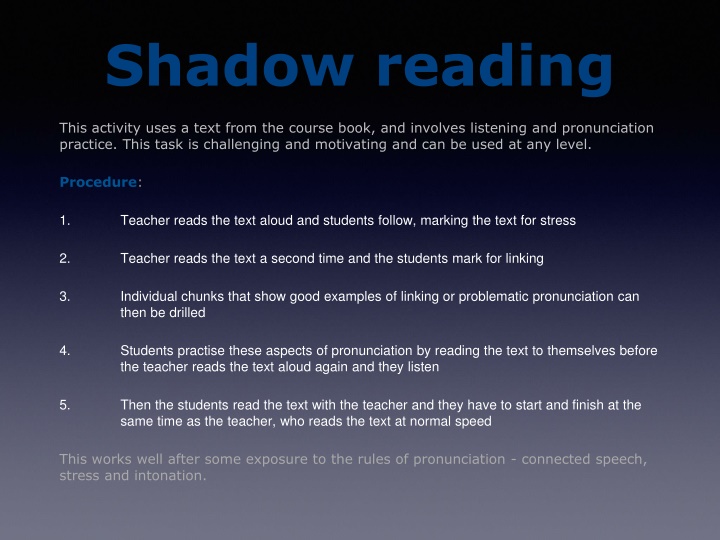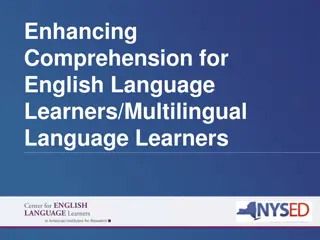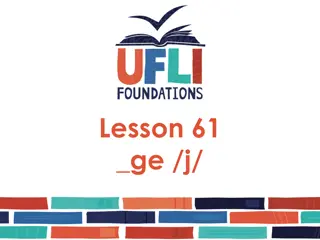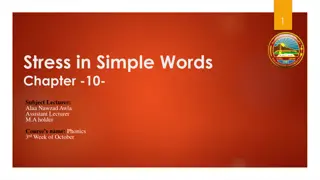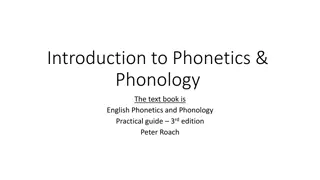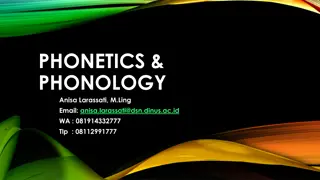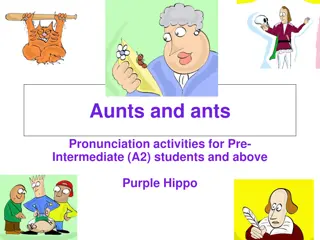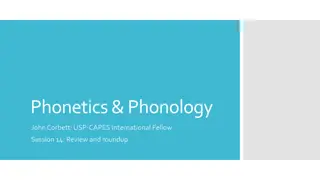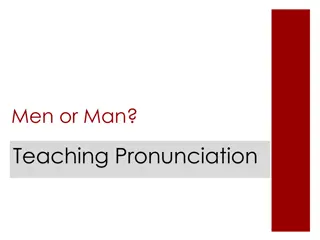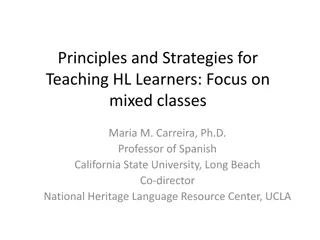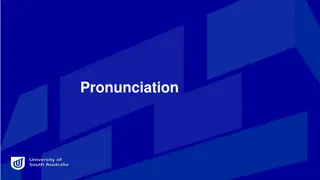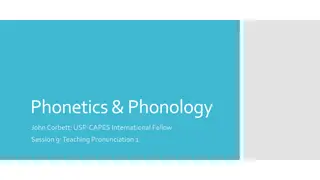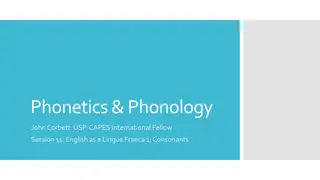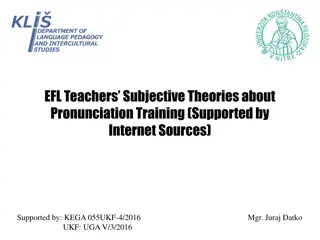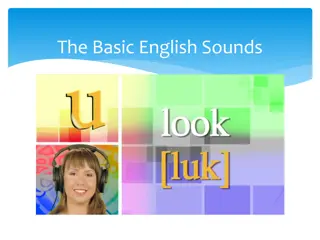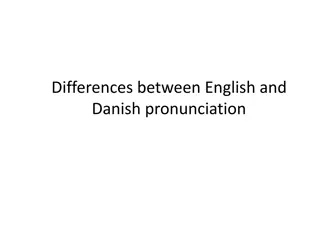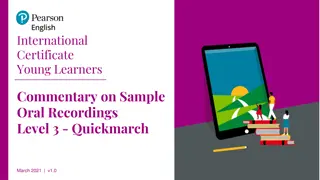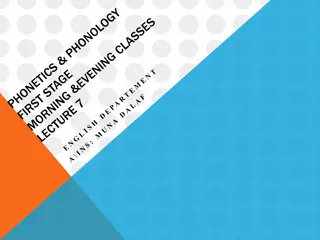Engaging Pronunciation Activities for Language Learners
Engage language learners with activities like shadow reading, tongue twisters, and "Have You Ever..." to improve pronunciation, stress, and intonation. These interactive tasks involve listening, speaking, and group participation, making the learning process challenging and enjoyable at any level. By incorporating these activities into language lessons, students can practice pronunciation rules and develop their speaking skills effectively.
Download Presentation

Please find below an Image/Link to download the presentation.
The content on the website is provided AS IS for your information and personal use only. It may not be sold, licensed, or shared on other websites without obtaining consent from the author.If you encounter any issues during the download, it is possible that the publisher has removed the file from their server.
You are allowed to download the files provided on this website for personal or commercial use, subject to the condition that they are used lawfully. All files are the property of their respective owners.
The content on the website is provided AS IS for your information and personal use only. It may not be sold, licensed, or shared on other websites without obtaining consent from the author.
E N D
Presentation Transcript
Shadow reading This activity uses a text from the course book, and involves listening and pronunciation practice. This task is challenging and motivating and can be used at any level. Procedure: 1. Teacher reads the text aloud and students follow, marking the text for stress 2. Teacher reads the text a second time and the students mark for linking 3. Individual chunks that show good examples of linking or problematic pronunciation can then be drilled 4. Students practise these aspects of pronunciation by reading the text to themselves before the teacher reads the text aloud again and they listen 5. Then the students read the text with the teacher and they have to start and finish at the same time as the teacher, who reads the text at normal speed This works well after some exposure to the rules of pronunciation - connected speech, stress and intonation.
The tongue twister game (1) All levels and ages enjoy tongue twisters. They work well as a warm up to get students speaking, and they help students to practise pronouncing difficult sounds in English. Procedure Write some English tongue twisters on the board or on pieces of paper to distribute to students. Ask them to read the tongue twisters aloud. Then faster. Then three times in a row. Here are some examples: She sells sea shells on the sea shore A proper copper coffee pot Around the rugged rocks the ragged rascal ran Red lorry, yellow lorry, red lorry, yellow lorry A big black bug bit a big black bear Peter Piper picked a peck of pickled peppers, Where's the peck of pickled peppers Peter Piper picked? Ask the students if they have any tongue twisters in their L1. Have a go at saying them yourself. This usually causes a good laugh, and makes the activity more two-way and interactive. Now ask the students to have a go at creating their own tongue twisters. This activity is a variation of the famous 'Consequences' game. Write the following questions on the board: 1. Write your first name 2. What did she/he do? 3. Where?
The tongue twister game (2) o o o Now give students the following instructions: Get into teams of about 5 people. On a piece of blank paper write your answer to question 1. Pass the paper to the person on your right. Write an answer to question 2 on the paper you have just received. Your answer must begin with the first sound in the person's name (e.g. Bob - bought a bike). Pass the paper on again and write an answer to question 3, again using the sound at the beginning of the name. Continue until all the questions have been answered. o o o o o o Pass the paper back to the person who started with it. Read all of the tongue twisters aloud. It might help if you give the students some examples before they begin the exercise: Bob bought a bike in Bali on his birthday because he was bored Susan sang a song at the seaside on the 6th of September because she saw some sunshine Laura laughed in the laundrette at lunchtime because she lost her laundry
Have you ever...? This activity practises have you ever...? to talk about life experiences. It is student led in terms of the content and is satisfying as a result. Preparation Print out and copy a bingo card and grid worksheet for each student. Procedure Elicit and write a list of about 20 irregular verbs (infinitive forms) on the board. Give out bingo cards and ask students to choose any 9 verbs from the board to write the past participle form on their cards. Play bingo by randomly selecting the verbs and calling out the infinitive forms. Students identify the verbs on their cards and cross them off until they have a line or full house depending on how you want to play. Elicit some life experiences from the students. Examples could include get married, have a baby, win a prize etc. Put students into groups, give them a piece of paper and ask them to brainstorm other life experiences. Monitor and provide help if necessary. Set a time limit. When finished write up all the experiences on the board. Give out the grid handout and ask students to fill in the grid with life experiences of their choice from the ideas on the board. Students then mix together and ask and answer questions to try to find someone who has had that experience. They should be encouraged to ask follow up questions and to talk to as many people as possible. Feedback by asking students to comment about their information. Extension
Inventions (1) This is a fun speaking activity in the form of a game. It can be used with most levels and most age groups. Students practise presenting their opinions and reaching agreement. There is an initial group work activity and extension speaking and writing activities. Activity: Inventions Activity type: Group work Level: Up to B2. Age: Adults or Senior YLs No materials required Preparation Write these inventions on the board in a random order: braille the internet light bulb telephone refrigerator thermometer microscope wheel paper printing
Inventions (2) Procedure Put students into groups of 3 or 5. Students should work together in their groups, checking that everybody knows what each word means. Help with understanding if necessary. Explain that these are 10 important inventions. Students should work together in their groups to compile a list of the inventions in chronological order. They should talk about each invention and reach a majority decision regarding the order. If necessary explain to students BC and AD. Elicit the lists from each group and write them on the board. Alternatively, invite a student up to the board from each group to write their list.
Inventions (3) Write the answers on the board (see below) for students to check. the internet (most recent) light bulb telephone refrigerator braille thermometer microscope printing paper wheel Get groups to copy the correct list. Explain that you are going to play a game. Students have to guess the year of each invention. They have to work together in groups to reach a majority decision. Explain that you will award 1 point for the group that writes the nearest year. You will award 2 bonus points for an exact year. Explain the meaning of BC and AD. Give students a limited time to do this part. (10 mins) Draw this grid on the board (below). Complete the grid by eliciting answers from each group. Alternatively, invite a member of each group up to the board to write in their information
Inventions (4) Complete the answers column (see below) and award points to find the winning group. Answers the internet 1969 light bulb 1906 telephone 1876 refrigerator 1850 braille 1829 thermometer 1593 microscope 1590 printing 1440 paper 100 wheel 3,500 BC Extension Writing: Students write a short text (100 words) about the positive and negative effects of one of the inventions named. Speaking: Put students into pairs; A and B. Students take turns to choose an invention from the list and to talk about its positive and negative effects. They should speak for about 2 minutes about each invention.
Desert island (1) This is a speaking activity based on the theme of being stranded on a desert island. It is suitable for pre-intermediate students upwards. Students design an island, create rules for it and decide who gets to live on it by way of interview. Preparation You will need some A3 paper and felt-tip pens. Procedure Ask students if they know of any TV programmes, films or books based on desert islands e.g. The Beach, Castaway, Robinson Crusoe, Survivor. In groups of 3 get students to explain the programme / film / book to each other. Try to get some feedback on the dangers and difficulties the main character faced living on these islands. Tell the students that they are going to design an island. Students work in 3s. 2 students draw 1 island together on the same A3 piece of paper following instructions from the 3rd student (e.g. Draw sharks in the sea). Change roles every few minutes. Allow ten minutes overall. Tell them they have to decide on rules for living on their island (e.g. You
Desert island (2) Ask the students to give a presentation to the whole class describing the island and explaining the rules for living on it. Explain that someone will arrive at their island and they must decide if they want to allow the person onto the island. They must make a questionnaire to ask the new arrivals. Elicit some good questions e.g. How do you make a fire? How do you defend yourself against a shark? Students write 6-8 questions in their groups. Choose one person from each group and tell them that their boat has sunk and they are swimming around looking desperately for an island. Tell students to go to an island where they will be interviewed The students swim / go to the other islands and are interviewed at each one. The group of students for each island decides which person they have chosen to live on their island and why. Together the swimmers decide which island they want to live on and why. Finish with some feedback on how well they did the tasks and how difficult it was.
OpenCities Budget (1) In this speaking activity students have to look at how to encourage migration to an imaginary city. They look at a number of projects to help support this and have to agree how to allocate a budget. The activity is based on themes from the British Council OPENCities project www.opencities.eu To find out more you can sign up for the OPENCitiesnewsletter Preparation Download a copy of the budget worksheet for each student. Budget Worksheet (pdf 48k) Procedure Ask students which they think is better, living in the countryside or living in a city. Put them in pairs to discuss the 'pros' and 'cons' of each. You can use images from Flickriver to help stimulate conversation and brainstorm some vocabulary. Click on this link to see urban images:http://flickriver.com/search/urban/ and this one for rural images: http://flickriver.com/search/rural/
OpenCities Budget (2) Once they have had some time to discuss, elicit some feedback on the problems of cities and some of the good things. Now tell them that they are going try to govern a small city. Give them the first part of the worksheet with the scenario on and ask them to read it. Check that they understand it and help with vocabulary. Next put the students into groups. Give some of the students roles within the group. Make one student (choose one of the stronger speakers) the chair person and tell the students to make sure everyone has a chance to share their opinion. Also make one student responsible for taking notes on the final budget. Now tell them to read through the problems and discuss them together, then decide on how much of the budget they will give to each project. To make this more challenging you could also tell them that they can only fund 6 of the 8 projects and two will have to be stopped. Give each group time to work at their budget. Once the groups have finished their discussion, tell them that they need to present their budget and the rationality for it. Give them some time to prepare a short presentation, then regroup the students so that they are with people from a different group and ask them to compare budgets. You could follow this up with a written task getting students to write up a draft proposal of their budget and the justification for their spending. An alternative approach to this discussion is to have groups of 8 people and make one person responsible for each project. They then have to argue for a percentage of the budget and convince others in the group that their project should be funded.
The press conference (1) This is a longer activity that needs some preparation. It's great for practising question forms in a fun way and gives structured speaking practice to lower levels. You will need a sticky label for each student or a pack of Post-It notes. This activity was first posted on the British Council's Language Assistant website Preparation Tell students that they have got the job of reporter for a magazine about famous people. They are going to interview some famous people and they need to prepare some general questions they can ask any famous person - actors, singers, sports stars, politicians etc. Give some examples, like, Do you enjoy your job?' or Are you happy being so famous?' and get students to write four questions and put them into a table with the questions going down the left hand side and space for five columns to the right. Then ask students which famous person they would like to be and give each one a sticky label or a Post-It note for them to write the name of the famous person on and stick on themselves. Procedure Put students into two concentric circles with the inner circle facing out and outer circle facing in.
The press conference (2) Tell students that they are going to interview the person directly in front of them for two minutes and note down all the information they find out. They are also going to be interviewed. The facing pairs take turns in the different roles of interviewer and famous person. At two-minute intervals shout stop' and ask the outer circle to step one person to the right. Shout start' to give students two more minutes with a new famous person. When each student has interviewed and been interviewed five or six times stop the activity and seat students. The information they have gathered about the famous people can then be shared with the group orally or used for a piece of writing for a gossip magazine. If you have an odd number rotate one person out of the circle each time you move the other circle around. This person can help you to monitor and can walk around the circle listening to the others in action and making a note of any mistakes they hear. This activity gets very noisy with a large group but it can be a great way to keep students speaking English for quite a long period of time and you will probably
